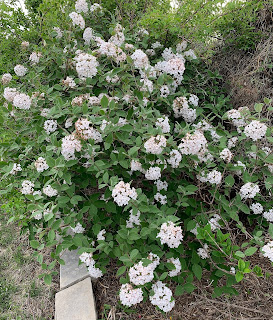 |
| 7/18/2019 |
In his blog, Noel was sharing the results of a seven-year experiment in planting density published in the April 2019 Plantsman. and he related how "delighted at how little time I spent on this (weeding), only a few minutes per plot per year." Despite the naturalistic planting methods he was investigating, he was able to conclude that, unlike previous widely-held gardener expectations, the plots did not become a monoculture of a dominant plant; "no one species took over." At least in Herefordshire, about as far from my Kansas environment, in terms of sunshine and moisture, as a garden can probably get.
 |
| 5/25/2019 |
The photo at the top of this blog was taken just this morning facing east at sunrise, and in a quick glance, you can take in blooming 'David' phlox, three varieties of daylilies, some bright red Monarda, and a white oriental lily. Faded away are the Paeonia tenuifolia and Iris, and waiting in the wings you can discern some garden sedum biding time until fall. Like Noel's experimental plot, I simply clear the dead foliage every spring and weed every third week for a few minutes.
 |
| Another view 7/13/2019 |
Another perspective of the bed, taken recently from the front, shows the opposite end of this bed, which I fully admit is mostly a morass of Knautia macedonia that is successfully outcompeting most of the daylilies and irises of this area and pushing the red Monarda to the edges of the Knautia empire. Next year, I need to remember to thin back the volunteer Knautia seedlings. I certainly don't want to eliminate it; Knautia macedonia was one of the first plants I sought out that was specifically recommended for the brutal Kansas climate and it survives the droughts that have killed off other groundcovers in the area.
Turning around from the previous perspective, facing west, the opposite bed is a mass of Orienpet lilies, and daylilies, with a rose or two thrown in. There is also a pair of barely visible panicled Hydrangea up against the garage here, planted just last year and yet to reach full growth. Some asters to the left are overgrown this year and yet to bloom.
So my obvious question now is, "Noel, how am I doing?" Aside from perhaps allowing the Knautia to self-seed a little too exuberantly (in defense of its neighboring plants, it seems to have been over-stimulated this year by the excess rain), am I approaching the new crowded-planting conception? Is there anything else you think I can crowd in here?















































